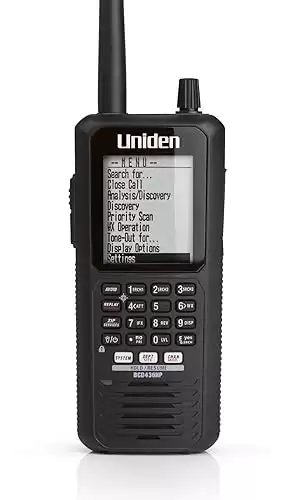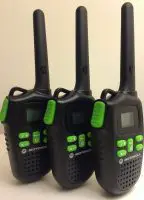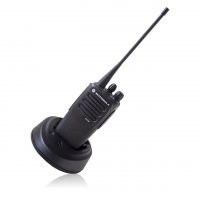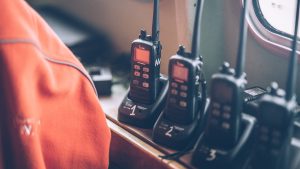If you have been considering purchasing the HG-UV98, then here’s everything you need to know to help you make your decision!
- Scanner knows what frequencies to scan from your ZipCode
- Interfaces with GPS to update scan frequencies from your location
- Easy to connect to a PC for programming and software updates
- Screen can be hard to read in bright light
- Some people may find the volume not to be loud enough
One of the benefits of the HG-UV98 is its ability to support both receive and/or transmit capabilities of 1200 baud AX.25 based APRS communications, but it’s not alone in this. It has some competition from popular models such as the Kenwood TH-D72, the ICOM ID-51A, and several other radios.
So, what sets the Anncus HG-UV98 apart from the competition? In the following review of the Anncus HG-UV98, we’re going to check out some of its features and what you can expect to get from your money.
Table of Contents
What Does Anncus HG-UV98 Stand Against?
When it comes to radios operating on a single battery and using dual-mode Bluetooth, the Anncus HG-UV98 seems to be the industry standard. The fact that it can transmit and receive the 1200 baud AX.25 capacity makes it one of the best radios highlighted by wireless connection, and that won’t be breaking your bank. Among the few models that we consider to be ideal competition are the Yaesu FT-2DR, Yaesu FT-3DR, as well as Kenwood D-72 and Kenwood D-74 that are quite a bit more expensive than the HG-UV98. For the English menus, the Anncus radio seems to be just the right fit, given its affordable price and a wide variety of sophisticated features, including a track timing mode, aerial flight measurement, and a smart mode.
While it would be even better if the Anncus HG-UV98 offered a digital mode, it is only a small downside compared to the fact that the data communication offered by this radio is extraordinary.
Basic Features of the Anncus HG-UV98
At first glance, there’s nothing extraordinary about the Anncus HG-UV98, except for the price. It’s extremely hard to find a radio with data communication for under $200, and the Anncus HG-UV98 does offer that over its competitors. The price of the Anncus HG-UV98 makes it extremely competitive on the handheld radio market and will give buyers something to think about.
If you’re interested in experimentation, telemetry, programming, hacking, or casual analog voice communication, then the Anncus HG-UV98 may appeal to you. The fact that it doesn’t only work as an outdoor communication device but also an automatic tracking control software and a radio that supports a real-time beacon interface are just some of the reasons why the Anncus HG-UV98 stands apart from its competitors.
The basic specifications of the Anncus HG-UV98 include:
- Receive – 136-174 MHz and 400-470 MHz.
- Transmit – 136-174 MHz and 400-470 MHz.
- Transmit Output – VHF = 5W High, 1W Low, UHF 4W High, 1W Low.
- Memory Channels – 128.
- Battery – 7.4 V 2500 mAh polymer Li-Ion.
Some of the more exciting features of the Anncus HG-UV98 include:
- 1200 Baud APRS RX & TX
- Location With GPS, Beidou, GLONASS Selection
- Temperature Sensor
- Barometric Pressure Sensor
- Battery Voltage Telemetry
- One Additional External I/O
- Bluetooth For PC/Phone Pairing For APRS/GPS
- VHF & UHF Simultaneous Reception
- 5 V USB Charging (Standard USB Micro Connector)
- Color Display With Day/Night Option
About the Non-APRS Features
It has all the standard voice communication functions found in modern handheld analog FM radios, such as PL/CTCSS, DCS encode or decode, radio channel, relay channel naming, and many others.
The HG-UV98 can also be used as a real-time dual watch in the same band but not as a dual receiver in the same band. Dual-band receiving is available, which means a signal at 145.880 and 435.350 MHz can be received simultaneously through the speaker. Those interested in duplex operation via SO-50, AO-92, AO-91, and a few additional satellites may be interested in this.
Among several innovative features, this Anncus radio includes a location sharing function, a location tracking function, and a power-saving function.
The audio mixer function seen on Kenwood and Yaesu radios is not available on the HG-UV98. On the “A” or “B” side of the HG-UV98, however, you can enable mute, which is useful if you want to use APRS on “A” but not hear the packet data bursts while listening to voice conversation on the “B” side. Depending on the user’s preference, this can also be flipped.
One of the coolest points about this product is that it is friendly for amateur radio enthusiasts. It offers a great intensity of trial use and features a detailed instruction manual with all of the information on setting up the software and using this radio.
You can mute both sides of the radio at the same time, which could be useful if you want to set APRS for both UHF and VHF at the same time as a tracking device and not have any RX audio coming out of the speaker, regardless of how the master volume knob is set.
This radio can work on a couple of modes, including display modes, Intelligent mode, intelligent power saving mode, and manual mode.
As mentioned above, the relay function and the handset’s built-in Bluetooth are the main reason why this radio is perfect for a wide variety of outdoor activities.
Anncus HG-UV98 Hardware Features
Along with the features of the Anncus HG-UV98, you also have the hardware to consider. In this section of the Anncus HG-UV98 review, we’ll take a closer look at the hardware and what you’re getting for your money when you purchase the Anncus HG-UV98.
The Anncus HG-UV98 includes a 2500 mAh battery with a 7.4V capacity. It’s a pretty standard-size battery for this radio model, but it’s not compatible with other brands. The unique part of the Anncus HG-UV98 battery is the Micro USB connector, which allows you to charge your battery via various connectors. It means that you can charge your Anncus HG-UV98 from your car’s 12V accessory socket or even a power bank if required.
The Micro USB port isn’t compatible with computer interfacing; however, the Anncus HG-UV98 is Bluetooth compatible and can be programmed via Bluetooth and also stream to GPS or APRS.
The exterior of the Anncus HG-UV98 is made from durable plastic and feels heavy, solid, and well-made. Its battery fits seamlessly into the case with a strong and secure clasp. In addition, the flat bottom on the Anncus HG-UV98 means that it will easily stand up on a flat surface without tipping over even with the LED light in the base.
The Anncus HG-UV98 features the SMA-J antenna connector. It’s the same antenna connector found on many other popular brands, including the Icom, Kenwood, and Yaesu radios.
The truly special thing is that the battery includes a USB small-scale connector. This permits you to charge the battery from either the included 12V to 5V USB “cigar/accessory” connector or the 120 VAC to 5V USB control 3d shape beside the included USB “A” to USB “Smaller scale Male” cable.
Many beginner radio sellers presently offer handheld radios with advanced voice capability such as DMR, Combination, or D-Star tweak modes, but still need simple to utilize information as it were capacities that work over distinctive merchants equipment.
The top of the radio moreover features a volume, and a control switch with a red, yellow or a green indicator depending on the mode that the radio is operating. The sophisticated exterior incorporates a match of programmable buttons and the PTT, which is angled for a feel sort of just like the one on the Yaesu FT-70DR and a few of the other “commercial inspired” radios. The Anncus HG-UV98 radio offers a unique approach to the conventional “Kenwood/Baofeng” 2 mouthpiece accessories.
It also features a built-in temperature detector and a set of accurate sensors for measuring atmospheric pressure that can be easily read on a 1.8-inch color LCD color display.
This same harbor is what is utilized to program the radio or APRS modem. The HG-UV98 can moreover be modified over Bluetooth and stream APRS, GPS, or both.
Designed as a radio suitable for outdoor rescues with a beginner-friendly grid positioning and the ability to set parameters in seconds
The front of the radio has a back-lit keypad and delicate capacities that are well thought out and permit a much simpler flipping of GPS and APRS capacities than a few other radios. The only complaint with the keypad is that each keypress has a loud tap sound, but this may be considered an advantage to a few clients unless you’re a James Bond-type on an extraordinary mission requiring supreme quiet.
On Bluetooth Connectivity
The HG-UV98 incorporates a Bluetooth network and the capacity to combine the radio with any gadget that anticipates getting KISS, UI, GPWPL, or KISS Acs. This all implies that the GPS and APRS information can consistently pass through to gadgets like a portable workstation, smartphone, or tablet when utilizing applications like Pinpoint, APRSdroid, or most other prevalent APRS or terminal programs like TeraTerm, Putty, and more. For those curious about Winlink, the HG-UV98 will work impeccably with that and will not require a wire associated with your computer. The wireless settings can reset to the firmware version at any point in time.
This may be offered to someone involved in “emergency amateur radio communications”. If all you have got is a computer and HG-UV98, you’ll likely put the radio in a tall tree to expand your APRS extent since it’ll at that point communicate back to your computer through brief-run Bluetooth. Having Bluetooth makes a few decent client application scenarios for the full two-way console to console communication when the HG-UV98 is remotely matched to other gadgets. Given the sophisticated connectivity of the Anncus HG-UV98, it is a great choice for strolling in an urban environment while receiving detailed real-time measurements of the surrounding conditions.
Software of the Anncus HG-UV98
The computer programming computer program, or CPS, is fundamental. It is utilized to program the channels and essential highlights of the radio, which are generally not related to APRS. It is conceivable that the broadly received C.H.I.R.P program can be made to work with the HG-UV98. Moreover, there’s an Android application accessible for the HG-UV98, but it is in the early stages at this time. There may be an isolated program bundle for programming the APRS highlights for the HG-UV98. This radio does offer third-party software support and intuitive map software that support versatile use.
This program is based on the APRS51 based tracker and modem gadgets found on eBay or somewhere else, which offers a few commonalities with other equipment. As mentioned above, changing between different settings and modes of the Anncus HG-UV98 is fairly simple thanks to the intuitive software. To adjust the radio to the factory settings of the HG-UV98, you should put the radio into update mode by holding down the PF1 side button like when you turn on the device. Most importantly, installing all firmware updates and making sure that your radio has the latest software settings is pretty simple.
Review of the APRS Features
You’re limited to 1200 baud for APRS or other AX.25 packet communication, as opposed to the faster but underutilized 9600 baud speed noted in the comparison table.
This isn’t a flaw, either, because the TNC on the HG-UV98 is hardware-based, which means more reliable packet decoding and encoding. According to testing, the general RX or TX experience is comparable to the Kenwood TH-D74, and the radio has not lost a packet while field testing it during a recent trip.
Before the Lanch HG-UV98, the most cost-effective “new buy” entry method to APRS was to utilize a simple $10 cable to connect a low-cost analog FM radio, such as a USD 25 Baofeng UV-82, to a smartphone.
Along with the common APRS functionalities, it includes 3. APRS one-button transmission beacon, beacon options, difference function, flashlight function, and holder with switch function.
This method employs an emulated software modem in smartphone or tablet software, as well as “voice activation” to switch from transmit to receive, which is not very dependable.
Unless you desire digital voice as found in other radios, the HG-UV98 should be your upgrade path if you had your first taste of APRS using this “Baofeng” approach. The contrast between the Lanch and the Baofeng UV82 or UV5R will be night and day especially considering the featured waypoint output, interval firing, default setting, beacon additional, beacon interface, and a sophisticated mobile station beacon.
The few advantages of the featured APRS functionality include:
- Setting a different RX or TX channel for APRS.
- For APRS, you can use a distinct channel, two channels, or one channel over Bluetooth.
- Using several UNPROTO pathways on various schedules (WIDE1-1, ARISS, etc.)
- Setting APRS TX at predetermined intervals, after each PTT, or using smart options based on speed, for example.
- Toggle the TX of in-built atmospheric telemetry or voltage sensor data on and off.
Anncus HG-UV98 Compatibility Issues
The recorded Kenwood and Yaesu radios can get and transmit 1200 baud APRS, hence making them 100% consistent for two-way information communications with the HG-UV98. The Anytone AT-D878UV can transmit APRS, so whereas those can be achieved on the HG-UV98, you’ll be able not to transmit APRS back to the Anytone, anticipating the client will get the message.
The two-way communication depends on a hotspot and a repeater operating APRS technology that is similar to radios such as ID-51, and Anytone D878. This is often NOT the same as genuine APRS communication, so don’t be tricked.
Still, that doesn’t affect the fact that this radio can be connected with APRS channel APRS channel, voice channel, Channel AB, English channel and also features a rich data analysis function remote turn-off function GPS/Beidou for enhanced outdoors use.
Review for the Anncus HG-UV98 – Conclusion
If you have the time to experiment with the Anncus HG-UV98, you will find a lot of value for money from this handheld radio. While the software could be tidied up a bit to present a more user-friendly display, the Anncus HG-UV98 offers a variety of different features which represent good value for money. The dynamic navigation function doesn’t only go a long way for map navigating but also helicopter aerial.
There is also an Android App that allows for programming the Anncus HG-UV98 via Bluetooth. The hardware and external casing and features of the Anncus HG-UV98 represent great value for money, and overall, it’s a fantastic radio which offers good value for money.
If you haven’t got time to learn the more technical aspects of the software, then spending a little more on a different radio could save you some time and effort.
Hopefully, now you have a much clearer idea of whether or not the AnncusHG-UV98 is the handheld radio for you! If you have any questions about the HG-UV98 or would like to learn more, please don’t hesitate to comment below or contact us directly. Also, if you have any feedback that you would like to share about the HG-UV98, please comment below.






